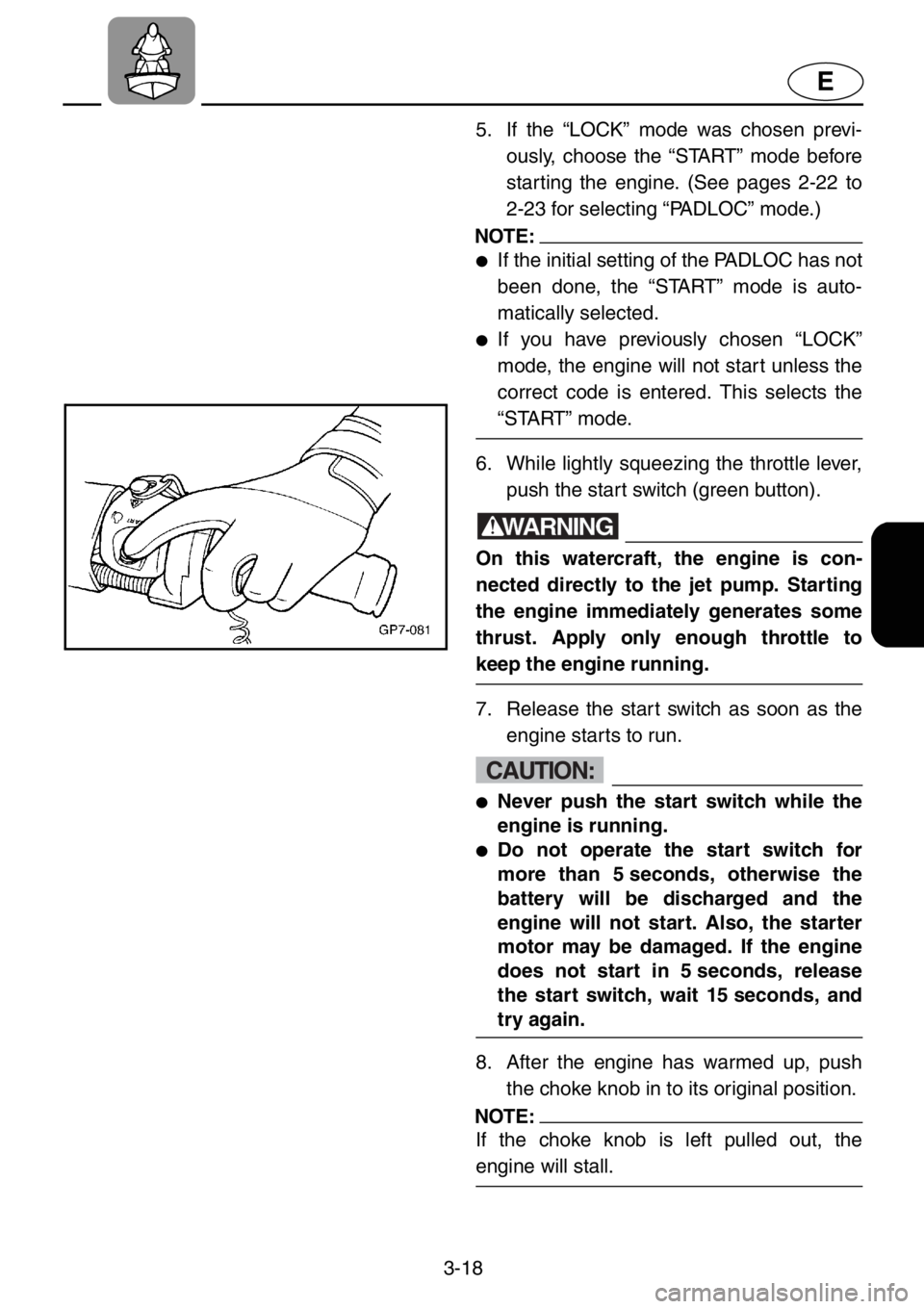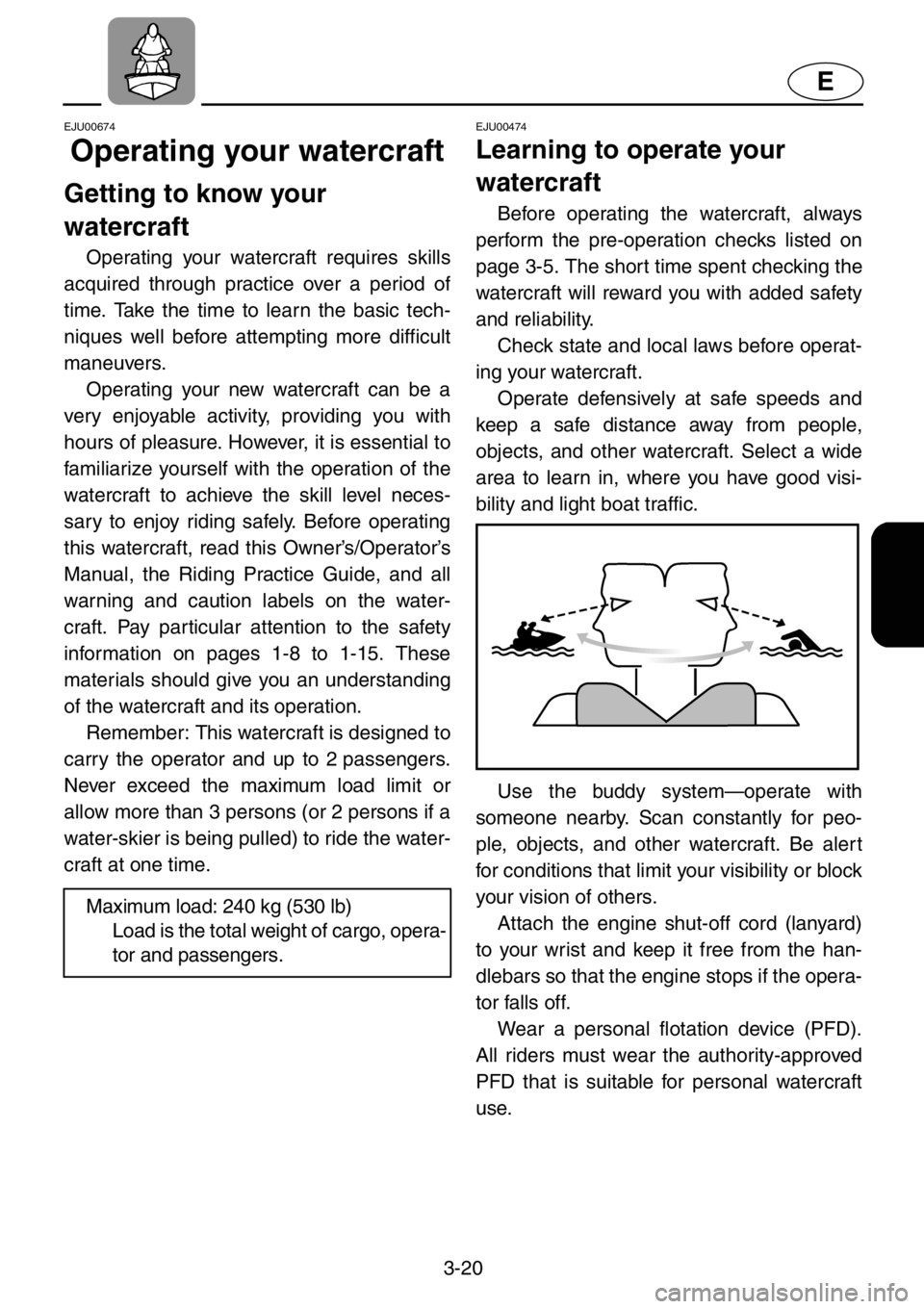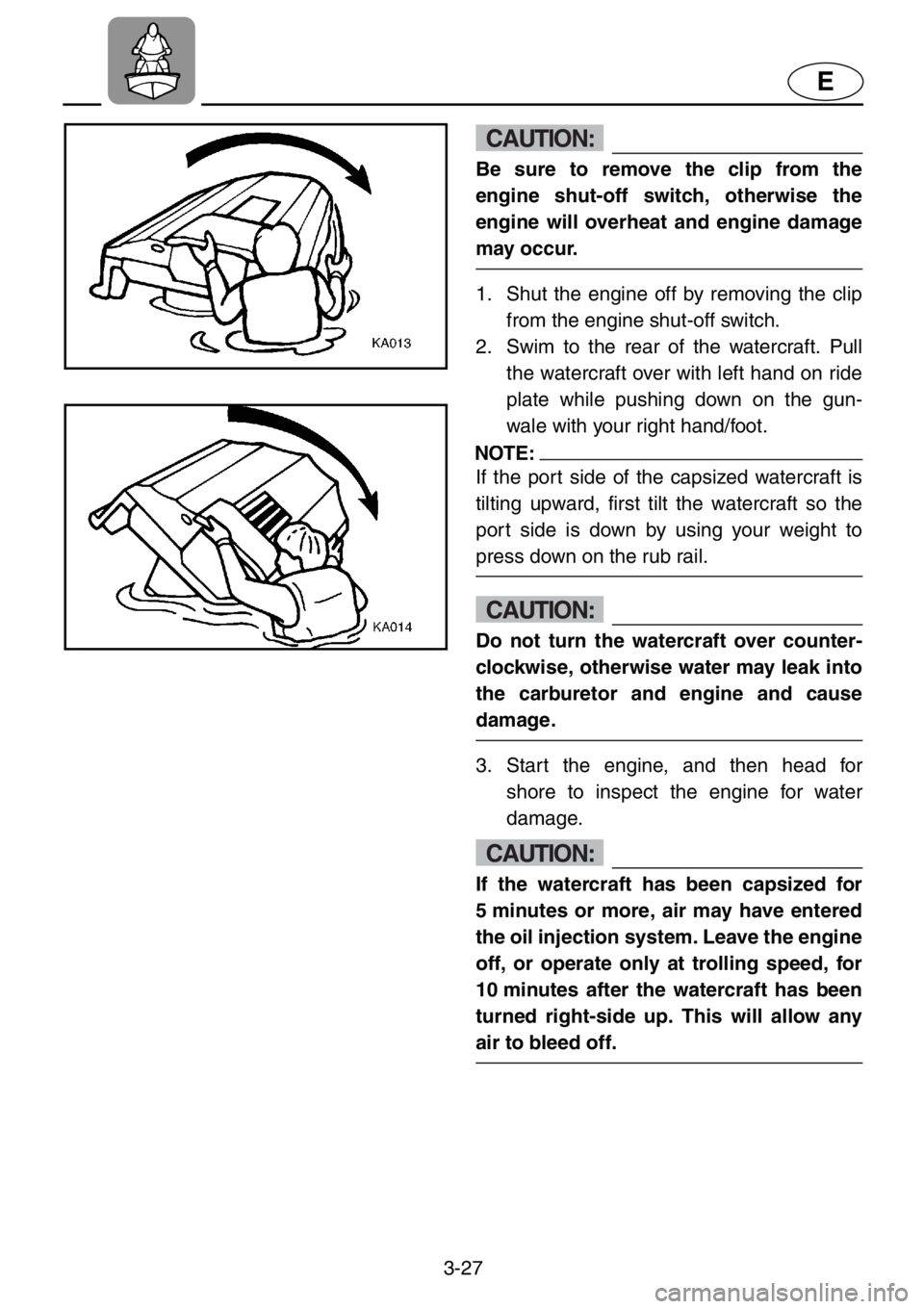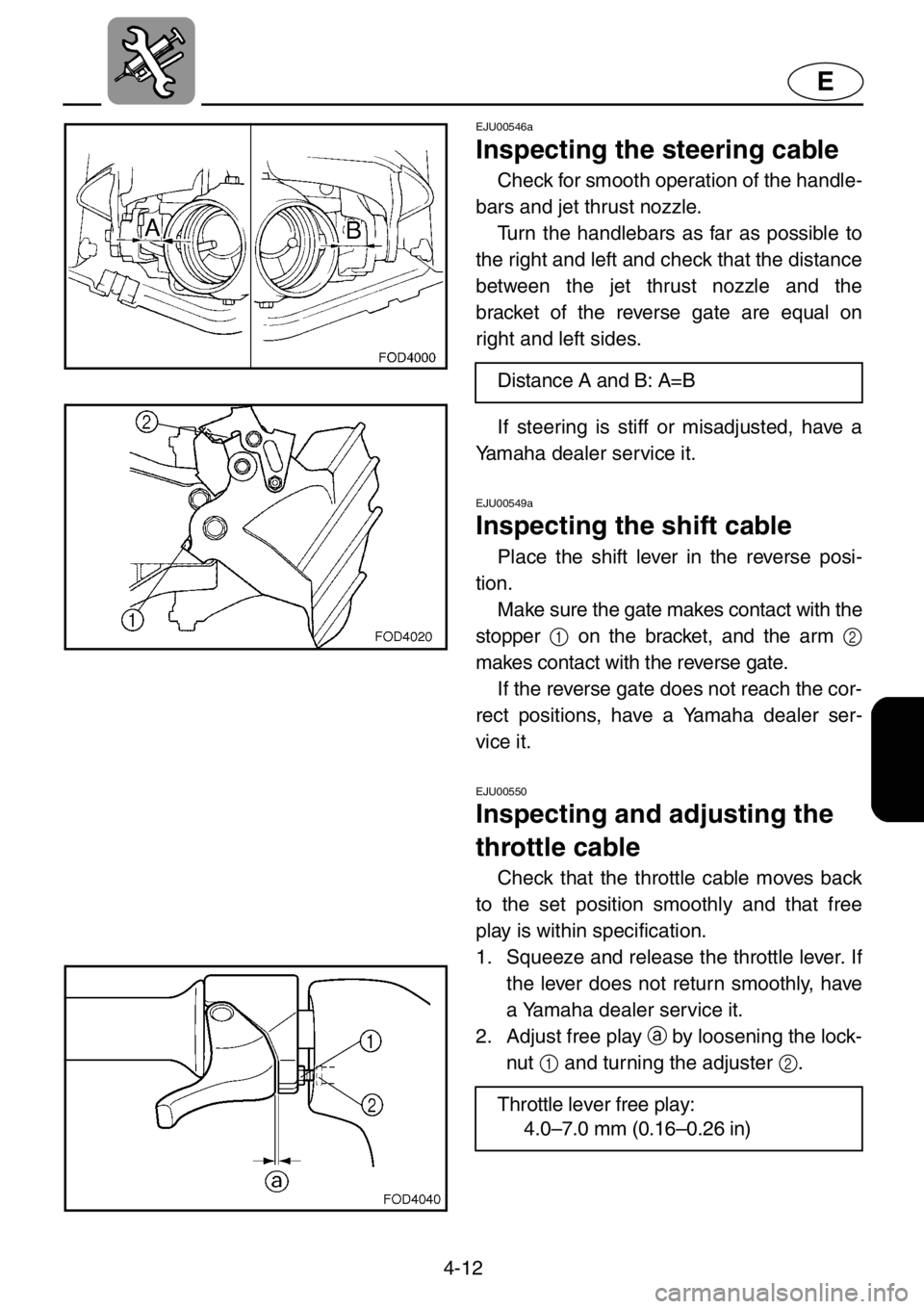Page 66 of 131
3-9
E
F0P03010
EJU00728
Fire extinguisher
Check that there is a full fire extinguisher
on board. The fire extinguisher container 1
is located in the front storage compartment.
To open the fire extinguisher container
cap2 turn it counterclockwise.
After inserting the fire extinguisher make
sure that the container cap is tightened
securely.
NOTE:
●See the instructions supplied by the fire
extinguisher manufacturer for checking
the fire extinguisher. Always keep the
extinguisher in the fire extinguisher con-
tainer.
●Always carry a fire extinguisher on board.
A fire extinguisher is not standard equip-
ment with this watercraft. If you do not
have one, contact a Yamaha dealer or a
fire extinguisher dealer to obtain one
meeting the proper specifications.
Page 67 of 131
3-10
E
EJU00447
Throttle
Squeeze and release the throttle lever
several times to make sure that there is no
hesitation in its travel. It should be smooth
over the complete range, and spring back to
the idle position when released.
WARNING
Before starting the engine, always check
the operation of the throttle lever. It
should move smoothly through its full
range of operation, and should spring
back to the idle position when released.
EJU00448
Steering system
Check for looseness in the handlebars.
Turn them as far as possible to the right
and left to make sure that operation is
smooth and unrestricted throughout the
whole range. Make sure that the jet thrust
nozzle also changes directions as the han-
dlebars are turned, and that there is no free
play between the handlebars and the jet
thrust nozzle.
Check that the tilt lever is locked in posi-
tion. (See Tilt lever on page 2-13.)
Page 75 of 131

3-18
E
5. If the “LOCK” mode was chosen previ-
ously, choose the “START” mode before
starting the engine. (See pages 2-22 to
2-23 for selecting “PADLOC” mode.)
NOTE:
●If the initial setting of the PADLOC has not
been done, the “START” mode is auto-
matically selected.
●If you have previously chosen “LOCK”
mode, the engine will not start unless the
correct code is entered. This selects the
“START” mode.
6. While lightly squeezing the throttle lever,
push the start switch (green button).
WARNING
On this watercraft, the engine is con-
nected directly to the jet pump. Starting
the engine immediately generates some
thrust. Apply only enough throttle to
keep the engine running.
7. Release the start switch as soon as the
engine starts to run.
CAUTION:
●Never push the start switch while the
engine is running.
●Do not operate the start switch for
more than 5 seconds, otherwise the
battery will be discharged and the
engine will not start. Also, the starter
motor may be damaged. If the engine
does not start in 5 seconds, release
the start switch, wait 15 seconds, and
try again.
8. After the engine has warmed up, push
the choke knob in to its original position.
NOTE:
If the choke knob is left pulled out, the
engine will stall.
Page 76 of 131
3-19
E
EJU00463a
Stopping the engine
To stop the engine, release the throttle
lever, and then push the engine stop switch
(red button).
WARNING
You need throttle to steer. Shutting off
the engine can cause you to hit an obsta-
cle you are attempting to avoid. A colli-
sion could result in severe injury or
death.
EJU00005n
Leaving the watercraft
If leaving the watercraft, choose the
“LOCK” mode on the multifunction meter by
setting PADLOC, and remove the engine
shut-off cord to reduce the chance of acci-
dental starting or unauthorized use by chil-
dren or others.
To set the mode, see PADLOC under Mul-
tifunction meter.
Page 77 of 131

3-20
E
EJU00674
Operating your watercraft
Getting to know your
watercraft
Operating your watercraft requires skills
acquired through practice over a period of
time. Take the time to learn the basic tech-
niques well before attempting more difficult
maneuvers.
Operating your new watercraft can be a
very enjoyable activity, providing you with
hours of pleasure. However, it is essential to
familiarize yourself with the operation of the
watercraft to achieve the skill level neces-
sary to enjoy riding safely. Before operating
this watercraft, read this Owner’s/Operator’s
Manual, the Riding Practice Guide, and all
warning and caution labels on the water-
craft. Pay particular attention to the safety
information on pages 1-8 to 1-15. These
materials should give you an understanding
of the watercraft and its operation.
Remember: This watercraft is designed to
carry the operator and up to 2 passengers.
Never exceed the maximum load limit or
allow more than 3 persons (or 2 persons if a
water-skier is being pulled) to ride the water-
craft at one time.
EJU00474
Learning to operate your
watercraft
Before operating the watercraft, always
perform the pre-operation checks listed on
page 3-5. The short time spent checking the
watercraft will reward you with added safety
and reliability.
Check state and local laws before operat-
ing your watercraft.
Operate defensively at safe speeds and
keep a safe distance away from people,
objects, and other watercraft. Select a wide
area to learn in, where you have good visi-
bility and light boat traffic.
Use the buddy system—operate with
someone nearby. Scan constantly for peo-
ple, objects, and other watercraft. Be alert
for conditions that limit your visibility or block
your vision of others.
Attach the engine shut-off cord (lanyard)
to your wrist and keep it free from the han-
dlebars so that the engine stops if the opera-
tor falls off.
Wear a personal flotation device (PFD).
All riders must wear the authority-approved
PFD that is suitable for personal watercraft
use. Maximum load: 240 kg (530 lb)
Load is the total weight of cargo, opera-
tor and passengers.
Page 79 of 131
3-22
E
EJU00484
Starting the watercraft
WARNING
●Scan constantly for people, objects
and other watercraft. Be alert for con-
ditions that limit your visibility or block
your vision of others.
●Operate defensively at safe speeds
and keep a safe distance away from
people, objects, and other watercraft.
●Do not follow directly behind water-
craft or other boats. Do not go near
others to spray or splash them with
water. Avoid sharp turns or other
maneuvers that make it hard for others
to avoid you or understand where you
are going. Avoid areas with sub-
merged objects or shallow water.
●Take early action to avoid collisions.
Remember watercraft and other boats
do not have brakes. Do not release the
throttle when trying to steer away from
objects—you need throttle to steer.
●Practice reboarding in shallow water
before riding in deep water.
Page 84 of 131

3-27
E
CAUTION:
Be sure to remove the clip from the
engine shut-off switch, otherwise the
engine will overheat and engine damage
may occur.
1. Shut the engine off by removing the clip
from the engine shut-off switch.
2. Swim to the rear of the watercraft. Pull
the watercraft over with left hand on ride
plate while pushing down on the gun-
wale with your right hand/foot.
NOTE:
If the port side of the capsized watercraft is
tilting upward, first tilt the watercraft so the
port side is down by using your weight to
press down on the rub rail.
CAUTION:
Do not turn the watercraft over counter-
clockwise, otherwise water may leak into
the carburetor and engine and cause
damage.
3. Start the engine, and then head for
shore to inspect the engine for water
damage.
CAUTION:
If the watercraft has been capsized for
5 minutes or more, air may have entered
the oil injection system. Leave the engine
off, or operate only at trolling speed, for
10 minutes after the watercraft has been
turned right-side up. This will allow any
air to bleed off.
Page 105 of 131

4-12
E
EJU00546a
Inspecting the steering cable
Check for smooth operation of the handle-
bars and jet thrust nozzle.
Turn the handlebars as far as possible to
the right and left and check that the distance
between the jet thrust nozzle and the
bracket of the reverse gate are equal on
right and left sides.
If steering is stiff or misadjusted, have a
Yamaha dealer service it.
EJU00549a
Inspecting the shift cable
Place the shift lever in the reverse posi-
tion.
Make sure the gate makes contact with the
stopper 1 on the bracket, and the arm 2
makes contact with the reverse gate.
If the reverse gate does not reach the cor-
rect positions, have a Yamaha dealer ser-
vice it.
EJU00550
Inspecting and adjusting the
throttle cable
Check that the throttle cable moves back
to the set position smoothly and that free
play is within specification.
1. Squeeze and release the throttle lever. If
the lever does not return smoothly, have
a Yamaha dealer service it.
2. Adjust free play a by loosening the lock-
nut 1 and turning the adjuster 2. Distance A and B: A=B
Throttle lever free play:
4.0–7.0 mm (0.16–0.26 in)